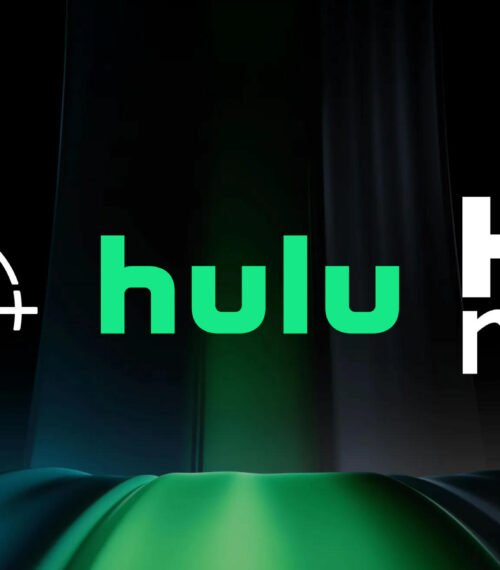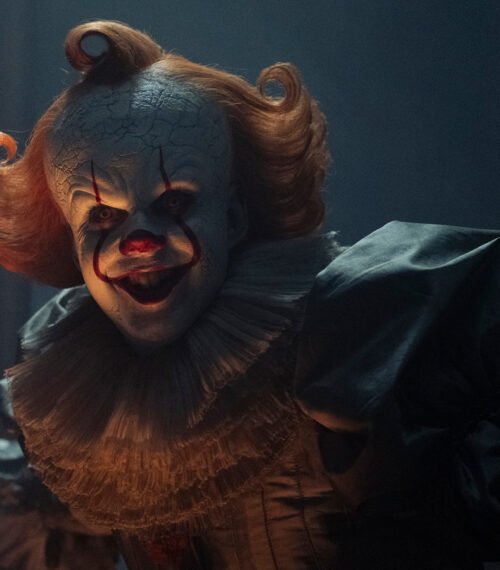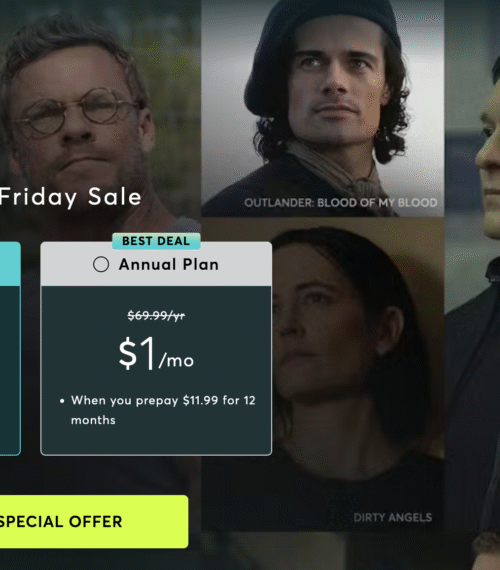What a year for new shows. As TV Guide narrowed down our favorite series of 2025, what stood out was how many of them — more than half — premiered this year. And not one of those new shows is part of a franchise. It isn’t easy to get any TV series made these days, especially when it isn’t a spin-off of a spin-off, but the ones that beat the odds did it in style. Plenty of them were also massive, Emmy-winning hits, because nothing is more exciting than original storytelling.
This year, Pluribus followed in the footsteps of Severance as a truly fresh Apple sci-fi series that got everyone talking. The Lowdown dug deep into Tulsa’s underbelly for a vibrant noir mystery. The Chair Company uncovered an absurd conspiracy all its own. Long Story Short spanned decades of one family’s life with humor and care. Adolescence gave crime drama a new look with its immersive one-shot filmmaking. And The Pitt took a similar real-time approach, with every episode chronicling one hour in a chaotic emergency room. The series was also a nostalgic throwback to network TV’s heyday, but bringing a broadcast-style workplace drama to streaming was its own kind of innovation.
Plenty of returning shows had great years, too — just look to our No. 1 show for proof — and one series on our list made the most of a major cinematic universe. But take a minute to appreciate the new shows and novel ideas that arrived when we needed them most.
These are TV Guide’s picks for the 10 best TV shows of 2025.
Honorable mentions: Dark Winds, Dying for Sex, The Rehearsal, Task, Too Much
10. Taskmaster (Channel 4)
The addition of a gleefully unhinged American dead set on destroying everything in his path — Jason Mantzoukas, to be specific — is exactly what Taskmaster‘s 19th season (or, as co-host Alex Horne corrects Mantzoukas early in the premiere episode, 19th series) needed. The British game show had a hall of fame-worthy run of episodes in 2025, with Mantzoukas joining English comedians Mathew Baynton, Fatiha El-Ghorri, Rosie Ramsey, and Stevie Martin on the panel of contestants accomplishing an array of strange tasks dreamed up by Horne, all with the ultimate goal of impressing taskmaster Greg Davies. The fact that such a long-running show could still be capable of reaching its comedic peak is incredible on its own, but it was the easy and immediate chemistry between the five contestants that gave the season its magic. Their reactions to Taskmaster‘s particular brand of mania were equal parts rage and amusement, creating so many standout moments — from “Javie Martzoukas” to El-Ghorri’s aggressive flirting with Davies to Bayton’s showstopping short shorts — that it almost feels wrong to single out just a handful. And I know I speak for all the fans when I say that Channel 4 still has the opportunity to put the ultimate cherry on top of Season 19 by releasing the six-minute math vs. maths debate. –Allison Picurro
9. Andor (Disney+)
Let’s start with the obvious: Andor is the best use of the Star Wars universe since The Empire Strikes Back. As we watched one of science fiction’s most adored properties get butchered and commercialized over decades, Tony Gilroy — who co-wrote the capable Star Wars standalone film Rogue One, which Andor is a prequel to — realized that the best way to make a Star Wars TV show was to tell an original story that weaves into the franchise rather than just fills in gaps, and his fearless take on contextualizing how evil the Empire is reshapes all of Star Wars from within. Knowing that he had a solid endpoint when the timeline caught up to Rogue One, Gilroy redlined Season 2 as far as it would go, showing the birth of a rebellion through the eyes of Cassian Andor (Diego Luna) while the bodies of countless friends and foes dropped around him. And like the best sci-fi, it spoke to real-world events that were happening around us — if the brutally violent and game-changing episode “Who Are You?” wasn’t a wake up call, then are your eyes even open? Andor was more than a show about fascism in a galaxy far, far away; each episode made you want to take to the streets to fight authoritarianism right in your own community, and made you realize you had friends everywhere. Not many TV shows in history have had that power. –Tim Surette
8. Adolescence (Netflix)
Adolescence gained most of its early attention when it was revealed that each hourlong episode was a single, continuous shot with no cuts, but it became the surprise hit of the year because there was so much more to talk about, too. In an ocean of forgettable TV, the four-episode limited series — which is now tinkering with how to make a Season 2 — opened up the dialogue on toxic masculinity, youth violence, and the ripple effect of a single, devastating action; delivered some of the year’s best acting performances, which led to a trio of Emmy wins for Stephen Graham, Erin Doherty, and brilliant then-14-year-old newcomer Owen Cooper; and peeled back the curtain on the painstaking technical process behind its unthinkable format (Episode 2 featured 300 child extras and a seamless transition from handheld camera to drone shot), which served the story rather than overshadowed it. To say that Adolescence is a complete series from its opening moments to its last is an understatement; few shows in 2025 were as attentive to every part of their being as Adolescence was. –Tim Surette
7. Long Story Short (Netflix)
As ambitious as it is intimate, Long Story Short
6. The Righteous Gemstones (HBO)
The Righteous Gemstones began its final season with a trip to the past — specifically, the 1860s. Danny McBride’s comedy opted for a standalone Season 4 premiere, casting Bradley Cooper in the role of the first Gemstone to wield a Bible, albeit under the most nefarious of circumstances. As big a swing as the episode was, it aligned with the mission Gemstones has had all along, exploring the root of America’s enthrallment with Christianity. McBride has made a career out of poking and prodding at the myths that shape American masculinity, but it was Gemstones‘ particular tenderness toward its titular family that made it feel so special. In its final episodes, it never sacrificed its profane, ribald sense of humor, allowing comedy to live alongside sincerity as it became a show about romance, about aging, about finding queer identity within religion. That it also packed in absurd details like Teenjus and Dr. Watson, while continuing to let its cast of comedic scene-stealers like Edi Patterson, Walton Goggins, and Tony Cavalero run wild, was nothing short of a miracle. The finale emphasized just how unique the bond between the three Gemstone siblings is, a perfect encapsulation of the series as a whole: There will never be another show like The Righteous Gemstones. –Allison Picurro
5. The Pitt (HBO Max)
At the end of the twelfth episode of The Pitt, night shift attending physician Dr. John Shen (Ken Kirby) asks, “When is this gonna end?” He’s talking about the incessant stream of victims arriving at the Pittsburgh Trauma Medical Center’s ER after a mass shooting at a nearby music festival. But Shen’s question applies more broadly to the HBO Max medical drama. To put it simply, The Pitt does not stop. From the time the clock strikes 7:00 a.m. at the start of Episode 1, the show follows senior attending physician Dr. Michael “Robby” Robinavitch’s (Noah Wyle) shift in the ER hour by hour. The result is a propulsive story that entirely transports the viewer to the hospital. Across the 15 hours during which Season 1 takes place, The Pitt introduces us to a team of doctors and nurses who save lives on a regular basis before unveiling how they themselves need saving. This dichotomy exists most glaringly in Robby, the heartbeat of the show. As his trauma becomes impossible to suppress, The Pitt makes it clear that diagnosis and treatment should not be limited to patients with visible symptoms — the ones healing them could have more urgent, invisible wounds. –Kat Moon
4. Pluribus (Apple TV)
A true original is a rare thrill. After the success of Better Call Saul, Vince Gilligan could have stayed put in the Breaking Bad universe; instead, he took a risk on a totally new idea, wagering that audiences still want to be surprised. He was right. Pluribus already has fans buzzing with theories, but forget about those: A theory presumes one right answer, and this isn’t a show that intends to tell anyone how to think. The series centers on Rhea Seehorn’s Carol Sturka, a bitter romantasy author clinging tight to her own misery, immune to the alien virus that has bound the rest of the world into a happy hive mind. It’s really a straightforward sci-fi premise, but its implications are endless. Meditative and unpredictable, Pluribus provokes questions about the nature of individuality, the limits of independence, and the worth of discontent; it echoes debates around artificial intelligence; it’s a portrait of addiction; it’s steeped in loneliness and grief. Any interpretation of its meaning is on the table. The show’s first priority is to be a story about Carol, who in record time has become one of the year’s most exciting characters: a prickly, funny, devastating, unlikely hero, and a worthy showcase for Seehorn’s exceptional talents. Watercooler television is back. Thanks, Carol. –Kelly Connolly
3. The Chair Company (HBO)
Tim Robinson’s ascent to the Mt. Olympus of alternative comedy was cemented with Netflix’s I Think You Should Leave with Tim Robinson, an absurd off-the-rails sketch show built on uncomfortable vibes rather than punchlines, so it’s understandable that even his biggest fans would have some hesitancy about his leap into the eight-episode serialized dark comedy The Chair Company. But it’s brilliant, and the best comedy of the year. Compared to some of his ITYSL classic clowns, Robinson goes mostly straight as Ron Trosper, whose run-in with a faulty chair humiliates him during a big work meeting and sends him hunting down conspiracy theories about an office supply manufacturer that may or may not be scheming funds through corporate shenanigans. The further Ron goes down his rabbit hole, the more he’s surrounded by the kind of eccentric goofballs Robinson has played before. What makes The Chair Company work is that despite the many hilarious Robinson-isms — a man eating food hidden in his inside coat pocket because he doesn’t like what’s served at a dinner party, a healthy text thread among members of a clothing store’s rewards club, a porno featuring Scrooge and a sexy Ghost of Christmas Future, to name a few — The Chair Company is actually a nerve-racking thriller on its own, and Robinson and co-creator Zach Kanin never forget that, even as someone puts their elbow in a bowl of soup. –Tim Surette
2. The Lowdown (FX)
The pleasures of The Lowdown are low tech. In Sterlin Harjo’s Tulsa noir, the community congregates in shops and on sidewalks, sometimes to talk and sometimes to throw punches. Plenty of those punches are thrown at Lee Raybon (Ethan Hawke, in his element), a rough-hewn rare bookstore owner and self-styled “truthstorian” who strolls around town kicking hornets’ nests as he roots out corruption. The plot is set into motion by Lee’s investigation into the suspicious death of one Dale Washberg (Tim Blake Nelson), the black-sheep son of a wealthy local family. But like Harjo’s first series, the miraculous Reservation Dogs, The Lowdown moves with a rambling spirit, letting its audience tag along as Lee gets into various scrapes. It’s fun just to watch this show humble its self-righteous hero, especially because Hawke is so game, but the vivid community around him is what really makes this the coolest show on TV. It’s got soul. The Lowdown‘s Tulsa is real enough that it hums with a menacing current of white supremacist violence, which touches every corner of the story. And yet the series is equally moved by writers and readers, fathers and daughters, grieving friends, street artists, late-night diner patrons, an old man (played by the late Graham Greene) whose faltering memory hasn’t forgotten the Osage Nation’s rightful land, and anyone engaged in fixing what’s broken. The powerful forces behind Dale’s fate aren’t all that shocking in the end, but people themselves are always surprising. –Kelly Connolly
1. Severance (Apple TV)
“Been a minute,” devout company man Mr. Milchick (Tramell Tillman) says early in Severance‘s second season, a cheeky comment aimed at both Mark (Adam Scott) and the audience who spent three impatient years waiting for Dan Erickson’s sci-fi workplace series to come back. Burdened is the show that returns for Season 2, especially one that debuted as thrillingly as Severance did. But in its second season, the series lost none of the confidence that made it such an enticing and addictive hit when it premiered back in 2022. The qualities that made it unique — a sly and strange sense of humor, dedicated world-building, eerily elaborate production design, mysterious baby goats — remained intact, and as the scope of the series widened, Severance‘s tremendous cast rose to the occasion. Season 2’s opening sequence found Ben Stiller’s camera following Mark down a frantic race through Lumon’s sterile halls, throwing the viewer right back into the show’s idiosyncratic universe alongside the character and quickly making it feel as though no time had passed.
In Season 2, Severance told its version of a coming-of-age story, as the no-longer-newborn innies pushed back against the outies who had created them only to imprison them, however unintentionally. The innies grew up and the show grew with them, becoming more ambitious as it experimented with its own carefully established framework. A frigid Macrodata Refinement team retreat took the innies outside and changed the entire direction of the season when Irving (John Turturro) unmasked Helly (Britt Lower) as her outie, Helena, who had infiltrated the severed floor. A dreamy interlude explained, in haunting detail, what Lumon had been doing to the supposedly dead Gemma (Dichen Lachman). Fundamental questions were asked and answered differently based on whose perspective the viewer chose to look at them from. Nowhere was that clearer than in the season finale, where the two Marks finally confronted each other via recorded messages. The scene illustrates the tragedy baked into Severance‘s premise: Both of these men exist, and they exist as different people with different wants, needs, and feelings, but they can’t exist simultaneously. This is what makes the finale’s final moments equally triumphant and devastating. It was an ending that frustrated some fans hoping for a more resolute conclusion. But if Severance‘s second season taught us anything, it’s that this show is more interested in the journey than in the destination. Praise Kier for that. –Allison Picurro















































































































